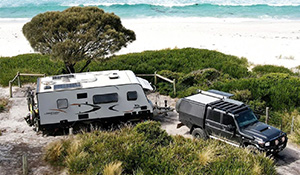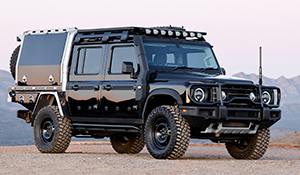Review: 2017 Land Rover Discovery 5 HSE TD6
What is the Land Rover Discovery 5 HSE TD6?
The Land Rover Discovery 5 is a large, premium 4x4 wagon with class-leading on-road performance and dynamics, combined with exceptional off-road capability.
Like its Range Rover and Range Rover Sport stablemates, this all-new Discovery is built on an aluminium monocoque platform which results in significant weight savings compared to the previous model Discovery.
It features fully independent suspension with height adjustable air springs, and is packed with technology that benefits on- and off-road performance and capability.
There are for model grades and three engine options in the Discovery 5 range. All four grades – S, SE, HSE and HSE Luxury – are available with a 132kW TD4 engine, a 177kW SD4 or a 190kW TD6.
The vehicle tested here is the Discovery HSE TD6.

Standard equipment on the Discovery HSE includes 20-inch alloy wheels, seven seats with leather trim and electric adjustment on the front seats, interior mood lighting, oak veneer trim, three-zone climate control air conditioning, a 10-inch touch screen, satnav, Meridian 380W 10-speaker sound system plus subwoofer, front and rear parking sensors, rain-sensing wipers, LED headlights, automatic high beam assist, fog lights, keyless entry and power tailgate.
The options list is extensive and includes various packages that cover styling, safety, comfort, technology and off-road capability.
There are also several standalone options such as an active locking rear diff, roof rails, tyre pressure monitor, Advanced Tow Assist, climate seats, active cruise control, park assist, surround camera system, powered gesture tailgate, rear-seat entertainment, head-up display and more.
While the styling of the previous-generation Land Rover Discovery 4 paid homage to the original Discovery, which was launched to an eager market back in 1989, this all-new model no longer features an upright two-box profile with deep windows and stepped roofline.
Instead it sports a far more svelte appearance that Land Rover hopes will appeal to a wider audience, at the risk of alienating a few traditionalists.

What’s the interior like?
The Discovery 5 automatically lowers on its air suspension to provide easy entry/exit. The driver’s position features a great range of adjustment to suit people of all shapes and sizes, but the ‘command’ driving position of previous Discovery models is no longer there to provide a good view over the bonnet.
The dash layout is a pleasing design and once you become accustomed to the location of switches and controls everything feels well laid out.
The wide 10-inch touch screen is positioned high on the dash where it’s easy to read and use, and its many functions have enabled the designers to keep the rest of the dash looking neat and uncluttered.
The big centre console is home to a rotary dial for the gear selector, which pops up when the engine is started. Behind this are the controls for the Terrain Response system, which are clearly marked, and the mode selection is also displayed on the instrument binnacle.

There’s a huge storage area under the armrest along with 12V and USB connectors. There’s another hidden storage bin behind the air conditioning controls and plenty of glovebox space.
Oh, and the curry hook has made a return; it’s located in the passenger side foot-well area and is designed to offer a handy place to hang a takeaway bag on the way home from the office.
There’s plenty of width across the second-row seat for three adults, good access to air conditioning controls and vents, and the centre position – which is usually an afterthought – is actually quite comfortable; the backrest isn’t too intrusive, the seat base is supportive and there’s good space for feet as there’s no big transmission hump on the floor.
The stadium seating arrangement of previous Discos, however, is no longer so pronounced; second-row occupants now sit quite low in the vehicle which affects forward visibility.
While access to the third-row seats is a little awkward, particularly for adults, there’s a surprising amount of space back there once seated.
Third-row occupants have their own storage bins and power outlets, and it’s surprisingly quiet in the back – maybe due to the vehicle’s aerodynamic profile and good tailgate seal – making it possible to converse easily with the driver from the third row.

It should be noted, however, that when the second-row seat is moved forward to allow access to the third row, it doesn’t lock into place, so if the vehicle is parked on an incline it can slide back on its runners without warning.
The new Discovery offers a large cargo area, even if it has lost some of the height of the previous model. With the second- and third-row seats folded flat there’s a claimed 2406L of cargo space, and you could easily lie down in there for a nap.
There are four decent luggage tie-down points for securing heavy items.
Access to the cargo area is via a one-piece lift-up tailgate. If opened with the key fob an internal panel drops that you can sit on.
When opened via the push button on tailgate itself, this panel stays in its upright position and acts as a load retainer. It’s clever and effective.
What’s it like on the road?
As a long-distance tourer, the Discovery 5 is supremely comfortable, especially in TD6 guise. The 3.0-litre V6 is very quiet and it exhibits none of the clatter that many diesel engines emit at idle.
The engine makes waves of torque from low in the rev range and the eight-speed ZF automatic transmission has so many ratios that gearshifts are barely perceptible at partial throttle.

As mentioned, the Discovery 5 is very quiet on the open road, with minimal wind noise and well-suppressed road noise.
Ride quality is also a Discovery strength, and the suspension soaks up bumps on crook secondary roads with aplomb.
The electric-assisted power steering is light around town but weights up nicely as speeds increase, and it provides a good connection between the steering wheel and what’s actually happening up front.
The Discovery’s weight-loss programme has worked wonders on the vehicle’s on-road handling.
It’s a whopping 480kg lighter than the previous model, which translates into improved steering response, less body roll when cornering and, of course, improved acceleration and braking.
In TD6 trim, the Discovery can accelerate from 0-100km/ in 8.1 seconds (the TD4 takes 10.5 seconds and the SD4 takes 8.3 seconds), which is certainly quick for a large 4x4 wagon.
But it’s the way the TD6 goes about it’s business that’s most impressive; it doesn’t need to be revved hard to deliver strong performance and it feels very relaxed on the open road.
And it’s also very economical, with a combined cycle fuel consumption figure of just 7.2L/100km.

What safety features does it get?
The Discovery 5 has a five-star ANCAP rating. Standard safety features include ABS, EBD, Emergency Brake Assist, Cornering Brake Control, Electronic Traction Control, Dynamic Stability Control, Lane Departure Warning, HDC with off-road ABS, Hill Launch Assist, Roll Stability Control, reverse camera, front side impact air bags, side curtain airbags and roll-over deployment of restraints.
So, what do we think of the Land Rover Discovery 5 TD6 HSE?
The TD6 is definitely the performance flagship of the Discovery 5 range, but it’s not light years ahead of the SD4 in terms of acceleration.
In fact there’s only 0.2 of a second separating them in the 0-100km/h sprint, yet Land Rover asks an additional $6711 for the TD6.
But as they say, too much power (or in this case torque) is never enough, and with 600Nm available from as low as 1750rpm, the TD6 is definitely the best option, especially for those who expect to carry a heavy load or tow a trailer.

What’s it like off the road?
As you’d expect of a Land Rover, the Discovery 5 has been designed to perform as well off the road as on it.
Thanks to height adjustable air suspension, good wheel travel, impressive low-range reduction and a suite of electronic traction aids, most owners would be blown away by its off-road capability.
Low-range reduction can be selected on the fly, at speed up to 60km/h, and the Discovery 5 is equipped with Terrain Response, which provides different driving modes dependent upon the terrain.
The modes are General driving; Grass, Gravel and Snow; Mud and Ruts; Sand; and Rock Crawl. Despite not being equipped with an optional rear diff lock, the test vehicle still conquered everything it was pointed at, including one particularly extreme hill with plenty of washouts.
The rear diff lock can be selected as a stand-alone option, or added as part of the optional Terrain Response 2 package, which also includes an innovative ‘auto’ mode for those who prefer the vehicle to automatically select the correct Terrain Response setting.

As well as an impressive off-road ground clearance of 283mm, the Discovery 5 has excellent approach, departure and ramp-over angles (34°, 30° and 27.5°), and a 900mm wading depth.
The standard wheel and tyre package lets the Discovery 5 down off-road. The test vehicle was fitted with 255/55R20 Goodyear Eagle tyres with a ‘W’ (270km/h) speed rating; great on the road, but prone to damage off it.
Land Rover recommends a Goodyear Wrangler Duratec in this size for off-road use; it has an all-terrain tread pattern and although it’s not a Light Truck (LT) tyre it certainly looks stronger than the standard Goodyear Eagle.
The only other notable downsides with the Discovery 5 off-road include visibility from the driver’s seat and manoeuvrabilty.
It’s difficult to see over the bonnet when cresting steep hills and the rounded shape of the vehicle makes it hard to figure out exactly where its extremities are.
And its overall size and relatively large 12.3m turning circle can make it hard to avoid ‘bush pinstripes’ when driving along heavily vegetated tracks.

Price: $100,261+ORC
Warranty: three years, 100,000km
Safety: 5 stars
Service Intervals: 26,000km/12 months
Engine: 3.0-litre V6 turbo-diesel
Power: 190kW at 3750rpm
Torque: 600Nm from 1750-2250rpm
Transmission: eight-speed automatic
Drive: Full-time 4WD
Dimensions: 4970mm (L); 2073mm (W); 1888mm (H); 2923mm (WB)
Turning Circle: 12.3m Boot Space 1137L/2406L
Ground Clearance: 283mm
Weight: 2230kg
Spare: full-size
Fuel Tank: 85 litres
Thirst: 7.2L/100km










